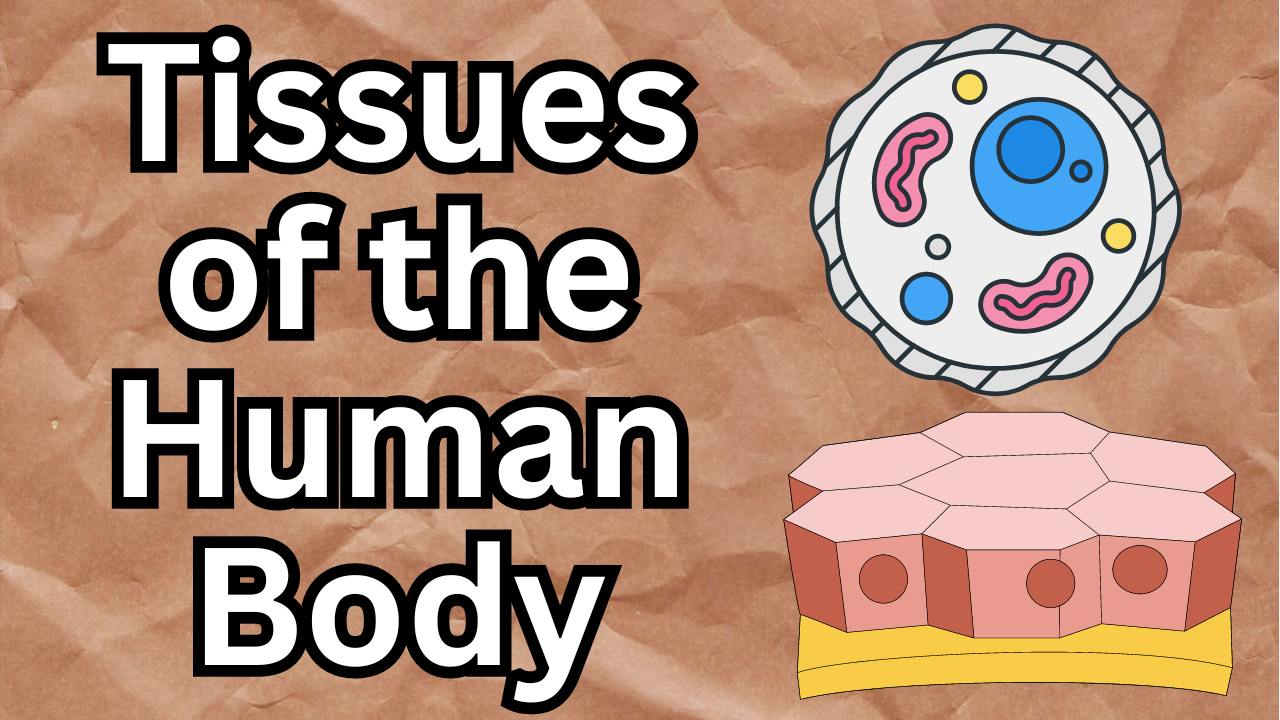Tissues of the Human Body
The human body is an intricate system composed of billions of cells, each specializing in performing specific functions to keep us alive. Cells with similar structure and function group together to form tissues, which are essential for the proper functioning of organs and organ systems. Understanding the types of tissues in the body is fundamental in human anatomy and physiology, as they serve as the building blocks for various physiological processes.
There are four primary types of tissues in the human body: epithelial tissue, connective tissue, muscle tissue, and nervous tissue. Each tissue type has distinct characteristics and functions that contribute to the overall health and maintenance of the body.
What are Tissues?
Tissues are groups of similar cells that work together to perform specific functions. A tissue’s structure is closely related to its function, meaning the type of cells that make up the tissue directly correlates with the role it plays in the body.
Classification of Tissues
Tissues are classified into four main types based on their function and structure:
- Epithelial Tissue
- Connective Tissue
- Muscle Tissue
- Nervous Tissue
1. Epithelial Tissue
Epithelial tissue covers body surfaces, lines internal organs, and forms glands. It acts as a barrier to protect the body from physical damage, dehydration, and infection while facilitating absorption, filtration, and secretion. The cells in epithelial tissue are tightly packed together, forming continuous sheets that may be single-layered (simple) or multi-layered (stratified).
Types of Epithelial Tissue
Epithelial tissue can be classified based on the number of layers and the shape of the cells:
1.1 Simple Epithelium
Simple epithelium consists of a single layer of cells and is primarily involved in absorption, secretion, and filtration.
- Simple Squamous Epithelium:
- Flat, thin cells that allow for efficient diffusion and filtration.
- Found in alveoli of the lungs, lining of blood vessels, and serous membranes.
- Simple Cuboidal Epithelium:
- Cube-shaped cells specialized in secretion and absorption.
- Located in kidney tubules and glandular ducts.
- Simple Columnar Epithelium:
- Tall, column-like cells that often have microvilli to increase surface area for absorption.
- Commonly found in the digestive tract lining (stomach, intestines).
1.2 Stratified Epithelium
Stratified epithelium has multiple layers of cells and is designed to protect against wear and tear.
- Stratified Squamous Epithelium:
- Multiple layers of flat cells that protect underlying tissues from abrasion.
- Found in the skin, mouth, esophagus, and vagina.
- Stratified Cuboidal and Columnar Epithelium:
- Rare in the human body.
- Found in some glandular ducts and parts of the male urethra.
1.3 Pseudostratified Epithelium
Pseudostratified epithelium appears to have multiple layers due to the varying height of cells, but in reality, it is a single layer. It is primarily involved in secretion and movement of mucus.
- Pseudostratified Ciliated Columnar Epithelium:
- Contains cilia and is found lining the trachea and upper respiratory tract, where it helps move mucus.
1.4 Transitional Epithelium
This type of epithelium is specialized to stretch and change shape. It is found in the bladder and urinary system, where expansion and contraction occur frequently.
Functions of Epithelial Tissue
- Protection: Acts as a barrier against mechanical injury, pathogens, and dehydration.
- Absorption: Involved in the absorption of nutrients and substances, particularly in the digestive system.
- Secretion: Forms glands that secrete hormones, enzymes, mucus, and other substances.
- Excretion: Assists in excreting waste products, such as sweat and toxins.
- Filtration: Involved in filtration processes, particularly in the kidneys.
2. Connective Tissue
Connective tissue supports, binds, and protects tissues and organs in the body. Unlike epithelial tissue, connective tissue cells are scattered within an extracellular matrix, which consists of fibers (collagen, elastin) and ground substances. This matrix determines the properties of the tissue, making it rigid (bone), flexible (cartilage), or fluid (blood).
Types of Connective Tissue
2.1 Loose Connective Tissue
Loose connective tissue has a relatively low fiber density, allowing for flexibility and support.
- Areolar Tissue:
- A loose network of fibers that fills spaces between organs and connects skin to underlying tissues.
- Contains fibroblasts, macrophages, and adipocytes.
- Adipose Tissue:
- Specialized in storing fat for energy, insulation, and cushioning.
- Found under the skin, around organs, and in bone marrow.
- Reticular Tissue:
- Forms the structural framework for organs like the spleen, lymph nodes, and bone marrow.
- Composed of reticular fibers and cells.
2.2 Dense Connective Tissue
Dense connective tissue is characterized by a high density of collagen fibers, making it strong and resistant to stretching.
- Dense Regular Connective Tissue:
- Collagen fibers are aligned in parallel bundles, providing tensile strength.
- Found in tendons (which connect muscle to bone) and ligaments (which connect bone to bone).
- Dense Irregular Connective Tissue:
- Collagen fibers are arranged in a random pattern, allowing the tissue to resist forces from multiple directions.
- Found in the dermis of the skin and joint capsules.
2.3 Cartilage
Cartilage is a flexible yet strong connective tissue found in areas requiring support and cushioning. It lacks blood vessels and heals slowly.
- Hyaline Cartilage:
- Provides smooth surfaces for movement at joints, supports respiratory structures.
- Found in the nose, trachea, larynx, and at the ends of long bones.
- Elastic Cartilage:
- Contains elastic fibers, making it flexible and resilient.
- Found in the ear and epiglottis.
- Fibrocartilage:
- The strongest type, with thick collagen fibers, providing shock absorption.
- Found in intervertebral discs and the menisci of the knee.
2.4 Bone (Osseous Tissue)
Bone is a rigid connective tissue that provides structural support, protection, and plays a role in mineral storage and blood cell production.
- Compact Bone:
- Dense and forms the outer layer of bones, providing strength.
- Spongy Bone:
- Found inside bones, it contains spaces filled with marrow and makes bones lighter.
2.5 Blood
Blood is a fluid connective tissue composed of cells (red blood cells, white blood cells, platelets) suspended in plasma. It is essential for transportation, regulation, and protection.
- Red Blood Cells: Transport oxygen and carbon dioxide.
- White Blood Cells: Defend against infections.
- Platelets: Play a role in blood clotting.
Functions of Connective Tissue
- Support and Structure: Forms the structural framework for organs and the body.
- Protection: Protects organs (e.g., bone, cartilage).
- Transport: Blood transports nutrients, gases, and waste products.
- Insulation: Adipose tissue stores fat and insulates the body.
- Repair: Connective tissues repair damaged tissues (e.g., blood clotting, bone healing).
3. Muscle Tissue
Muscle tissue is responsible for body movement and is specialized in contraction. It contains muscle fibers made up of actin and myosin, which allow the cells to shorten and generate force.
Types of Muscle Tissue
3.1 Skeletal Muscle
Skeletal muscle is voluntary, meaning it is under conscious control. It attaches to bones and is responsible for the movement of the body.
- Structure: Long, cylindrical, multinucleated cells with striations (bands).
- Location: Attached to bones via tendons.
- Function: Enables voluntary movement, posture maintenance, and heat generation.
3.2 Cardiac Muscle
Cardiac muscle is found only in the heart and is involuntary. It is responsible for pumping blood throughout the body.
- Structure: Short, branched, striated cells with a single nucleus and intercalated discs that allow synchronized contractions.
- Location: Found in the walls of the heart.
- Function: Contracts rhythmically to pump blood.
3.3 Smooth Muscle
Smooth muscle is also involuntary and is found in the walls of hollow organs like the intestines, blood vessels, and bladder.
- Structure: Spindle-shaped, non-striated cells with a single nucleus.
- Location: Found in the digestive tract, blood vessels, bladder, and uterus.
- Function: Regulates the movement of substances through the body (e.g., digestion, blood flow).
Functions of Muscle Tissue
- Movement: Enables body movement and locomotion.
- Posture: Maintains body posture and stability.
- Circulation: Pumps blood through the heart and blood vessels.
- Digestion: Facilitates digestion through smooth muscle contractions.
4. Nervous Tissue
Nervous tissue is specialized for communication and control within the body. It consists of neurons and supporting cells (neuroglia), which work together to transmit and process information through electrical impulses.
Structure of Nervous Tissue
- Neurons: The functional unit of the nervous system, neurons are specialized cells that transmit electrical signals.
- Cell Body (Soma): Contains the nucleus and organelles.
- Dendrites: Receive signals from other neurons.
- Axon: Transmits signals to other neurons, muscles, or glands.
- Neuroglia: Supporting cells that provide nutrients, protect neurons, and maintain the extracellular environment.
Functions of Nervous Tissue
- Sensory Input: Detects stimuli from the external and internal environments.
- Integration: Processes and interprets sensory information.
- Motor Output: Initiates responses by sending signals to muscles and glands.
The human body’s tissues form the foundation for its complex systems and functions. Each type of tissue, from the protective epithelial layers to the communicative nervous tissue, plays an essential role in maintaining the body’s homeostasis and facilitating biological processes. Understanding these tissues is crucial for grasping the intricate design and functionality of the human body.
MORE : Difference between Prokaryotes and Eukaryotes
<<<<<<<<<<<<JOIN US>>>>>>>>>>>>>>>>
| Subscribe our PHARMACY INDIA YouTube Channel for more Pharma Updates | Click Here |
| Follow us on Instagram | Click Here |
| Download PHARMACY INDIA MOBILE APP from Google Play Store | Click Here |
| Follow us on LinkedIn | Click Here |






